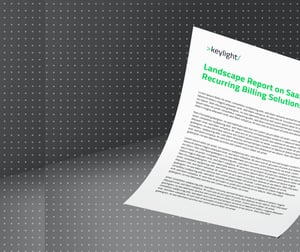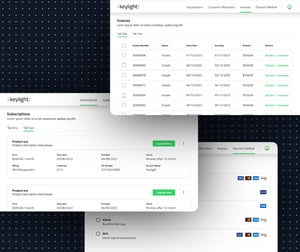The details of subscription projects
The best way to get everything you need
Before keylight developed a revolutionary subscription business platform, our teams worked for eight years implementing enterprise systems. We understand how to navigate the complexity of subscription projects and what it takes for them to be successful.
It's common to underestimate the details of a subscription project when there’s a world of similar billing tools and options for implementation available. That's why working with a vendor who doesn't simply provide a platform to revolutionize your tech stack, but works in partnership with you to implement it successfully, is the best way to get everything you need to optimize your business. Without the right technology and support, we have seen multiple businesses get stuck in a business setup that does not meet their needs, or even abandon expensive transformation projects because budgets run out.
In this article, we use our knowledge and expertise to look at the biggest risks involved in subscription projects and how to minimize them.
Common project scenarios
The two main risk profiles
Typically, there are two ends of the spectrum when it comes to subscription project risks, and these play out in scenarios similar to the following:

The project doesn't look to the future
The requirement sheet is brief, emphasizing billing automation with minimal user specifications, but there also isn't a roadmap for the business's future trajectory. The implementation project may be short, but the business vision is now limited by an inflexible billing solution, which demands extensive custom development for expanding customer journeys and market experimentation.
The project doesn't look to the future
The requirement sheet is brief, emphasizing billing automation with minimal user specifications, but there also isn't a roadmap for the business's future trajectory. The implementation project may be short, but the business vision is now limited by an inflexible billing solution, which demands extensive custom development for expanding customer journeys and market experimentation.

Trying to do everything at once
The business has a long requirement sheet for users and advanced automation that need custom UI and subscription logic to streamline business processes between teams. Thus, the implementation project is long, and without the right knowledge to manage the complexity, teams either need to compromise their vision at the end of their budget or give up altogether.
Trying to do everything at once
The business has a long requirement sheet for users and advanced automation that need custom UI and subscription logic to streamline business processes between teams. Thus, the implementation project is long, and without the right knowledge to manage the complexity, teams either need to compromise their vision at the end of their budget or give up altogether.
Minimizing risk
Top tips for successful subscription projects
Perhaps the biggest pitfall for subscription businesses embarking on transformation projects is the lack of certainty. Usually companies are aware of a long list of desired capabilities, but the investment costs are big and there’s no guarantee that the project will drive business. That might mean they give it a go and hope for the best, or they revert to a very short project and think they will deal with the implications later. There is however a third option—and that's to work with someone who really does understand the process and can help you manage the rollout, which is what we do at keylight.
Break out of the requirement battle
Stop battling with the list of requirements that your prospective system fills. Look at the system’s DNA to see if it's built to adapt to a changing list of requirements. As your business and the world around it grows, your requirement focuses will inevitably evolve, so an inbuilt platform flexibility is essential. In reality, most systems have the basic functions (like billing) sorted—what separates the wheat from the chaff is the ability to change and develop over time.
To minimize risk, ask yourself the following questions:
- Which system is built with the future in mind, and which ones are only built to automate the finance processes you need now?
- Is it a billing tool or a business system that can quickly adapt for commercial strategies?
- Is it configuration-based and rule-based?
- Is it API-first?
- Does it collect good data?
Look for pre-built subscription logic
Subscription businesses need a platform with pre-built subscription logic, not just billing functionality. This is a fundamental part of a platform's DNA—it can't be built onto it effectively. As recurring revenue is such a fundamental part of subscription businesses, getting this right from the start plays a major role in minimizing subscription project risk and maximizing long-term business success. Subscription logic that's unified across business functions is the key to automating business processes from commerce and billing, to accounting. When it's siloed and disconnected from self-service customer journeys, sales and partner sales, the user experience is compromised, errors occur and data is lost. Trying to customize that connection is often what causes subscription projects to be long, costly or to fail.
To minimize risk, ask yourself the following questions:
- Was the platform specifically designed for the unique requirements of subscription businesses?
- Was the platform built with the end-users in mind?
- Is the subscription logic unified across business functions?
- Is the sales person telling you that you can quickly build the missing logic? If so, walk away.
Implement transformation with an iterative approach
Subscription businesses are living entities, constantly evolving, growing, developing and adapting because that's how they retain the continuous customer relationships. For the perfectionist, that mindset can be a challenge because it means there's no such thing as a completed platform. However, there is such a thing as being market ready. Taking an iterative approach to project implementation is a much more practical solution, meaning you can manage the upfront project costs and minimize the costs of any business downtime during system development. It's not about compromising, but balancing wants, needs and practicality for a timely approach that will have the added benefit of enabling you to get feedback as you go and offset the costs of the system license and any other professional services by trading as soon as possible.
To minimize risk, ask yourself the following questions:
- Does the vendor offer an implementation timeline that is over six months?
- How much custom development is needed to go-live?
- Does the vendor brush you off when you raise these topics?
- Is there any assurance from the vendor if the implementation timeline is not met?
Designed for success
Count on a quality subscription platform
At keylight, our customers are in charge of their projects and we are here to provide not only a tried and tested platform designed specifically for subscription businesses, but also to offer a decade of R&D experience implementing subscription projects.
We know this is your business and our role is to give you the platform to operate it at its best, understanding the complexities of projects and the need for a practical, commercial approach that supports your business today and as it grows. We know you don't want to do this project twice, but we also know that every business has time and budget constraints.
That's why our platform has been created to shorten subscription projects from months to weeks, and sometimes even days, thanks to a rule-based approach that allows evolving requirements to be easily managed, and experienced teams dedicated to supporting customers who have outgrown their subscription tools.

Explore keylight's superior value compared to conventional subscription platforms
![]() Compare now
Compare now
Explore keylight's superior value compared to conventional subscription platforms
![]() Compare now
Compare now

Power your business
with the right subscription solutions
![]() Book a free consultation
Book a free consultation
Power your business
with the right subscription solutions
![]() Book a free consultation
Book a free consultation




